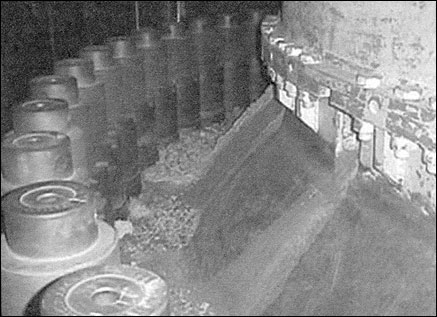Ohioans long knew FirstEnergy Corp. as the utility supplying electricity to the northern part of their state and as a near-monopoly that also owned power generation and distribution assets in Pennsylvania and New Jersey. The rest of the country became acquainted with the Akron, Ohio company after August 14, 2003, when a cascading series of power failures knocked out electricity to eight states and parts of Canada. It was the worst power failure in history, affecting more than 50 million people and causing six billion dollars in economic losses in the United States alone.
Within days, FirstEnergy came under the glare of national media and government investigators from the United States and Canada for its probable role in the blackout. By mid-November, when the joint task force investigating the power failure concluded FirstEnergy and its reliability coordinator bore the brunt of responsibility, reporters at The (Cleveland) Plain Dealer were deep into telling this story as a part of their investigative reporting on this local power company since the late 1990’s. This examination of FirstEnergy’s business practices, reliability record, and relationships with regulators was undertaken in response to proposed changes in national energy policy and Ohio’s move to deregulate its utilities.
These reporting efforts intensified after 2000. From both Cleveland and Columbus, the state capital, Plain Dealer reporters wrote that state regulators agreed to let FirstEnergy pass on $8.7 billion in transition charges to consumers in exchange for freezing rates. A collaborative investigation by reporters in Washington, D.C. and Cleveland led to stories being published about a rust hole and cracks in the reactor lid’s components at FirstEnergy’s Davis-Besse Nuclear Power Station and loose oversight by the U.S. Nuclear Regulatory Commission (NRC).
This meant that when power failed on the afternoon of August 14th, a core of FirstEnergy-savvy reporters were ready to take the lead in this breaking news story. There were no silver bullets. Ultimately, what led to some of the most compelling stories about this blackout was a smart blend of old-fashioned journalism and skillful use of information-age technology.

A darkened city skyline can be seen in Cleveland after the largest blackout in U.S. history left millions of people in the United States and Canada facing a second sweltering night without electricity. Ohio faced the worst water crisis in its history. Photo by Marvin Fong/The Plain Dealer.
Reporting on FirstEnergy
Working under a state mandate to relinquish monopolies of its three electric companies—Cleveland Electric Illuminating, Toledo Edison, and Ohio Edison—FirstEnergy proposed to state regulators in 2000 that it be allowed to recover the costs of the nuclear power plants it built as a regulated utility. In exchange, FirstEnergy would freeze electric rates through the end of 2005. State officials signed off on an agreement on July 19, 2000, and this allowed the utility to recover the costs of its nuclear projects by adding what appeared as transition charges on customers’ monthly bills. The deal allowed the utility to pass those charges, which average about $15 a month, even to consumers who switched to another electric supplier.
Julie Carr-Smyth, our paper’s state-house reporter who covers regulatory issues, wondered how FirstEnergy and state officials justified the pass-throughs to consumers. Carr-Smyth asked to see a study prepared for the Ohio Consumers’ Counsel by an independent consultant, LaCapra Associates of Boston, to determine how much FirstEnergy should be allowed to collect. Even though taxpayers bore the cost of the report ($579,000), the Consumers’ Counsel, Robert Tongren, successfully blocked at least a half dozen Freedom of Information Act (FOIA) requests from The Plain Dealer and other organizations. Tongren claimed the study was protected by confidentiality arguments and pending litigation.
More than a year later, energy reporter John Funk and science reporter John Mangels began looking into discussions between FirstEnergy and the NRC over when to shut down Davis-Besse, an aging nuclear power plant near Toledo, for a crack inspection. Davis-Besse is one of 69 pressurized water reactors in the nation’s nuclear fleet. Workers had spotted cracks and corrosion around the reactor head at least three years earlier, and the NRC wanted the inspection done by the end of 2001. FirstEnergy argued it could wait until the following April, during a scheduled refueling. Performing both tasks at the same time would save the utility millions, since when it is not operating the utility must buy replacement power at an average cost of $500,000 per day. (Davis-Besse supplies about seven percent of FirstEnergy’s generation.)
The NRC compromised and gave FirstEnergy until February 16, 2002. That inspection found the cracks were more serious than suspected because they involved the nozzles that carry control rods through the reactor lid and into the nuclear core. And on March 6, 2002, a worker trying to repair a cracked nozzle found something far more insidious: a pineapple-sized hole in the reactor lid. Only the lid’s thin stainless steel liner held back the 87,000 gallons of pressurized radioactive and superheated water from jetting through the rust hole and into the reactor’s containment building.
Two months later, Funk and Mangels learned much more was at stake than inept management and lax government oversight. A source informed them that the NRC had launched a criminal investigation into whether FirstEnergy withheld key information from federal agents about conditions at Davis-Besse. And in the early summer, another source sent them a box containing more than 3,000 pages of internal NRC documents. None of the content was redacted, as certain highly sensitive portions might have been had the reporters obtained the documents through an FOIA request.
Among other things, the documents showed how much FirstEnergy had pressured the NRC to delay the crack inspection. Roy Lessy, Jr., a veteran nuclear utilities lawyer, a partner in the nation’s 10th-largest law firm and former deputy chief counsel for the NRC, accompanied FirstEnergy engineers when they visited the NRC to make their case. Most interesting was that the papers revealed NRC managers themselves had pushed for the compromise that allowed FirstEnergy to run the reactor until the middle of February.
After the reactor lid hole was discovered, the NRC ordered FirstEnergy to replace, rather than repair, the reactor head, and this process was completed in September 2002. Still, Funk and Mangels pounded the Davis-Besse drum relentlessly, keeping the pressure on the NRC not to allow the utility to restart until all its acknowledged problems had been corrected. The reporting team produced an impressive array of major reports on some of the reactor’s problems, including the following public revelations:
- Davis-Besse’s emergency equipment had been seriously compromised and could not be counted on to work properly. Had the cracked lid burst, operators would have been challenged to keep the reactor’s nuclear core covered with water and safe from catching fire or melting. Experts called the existence of the hole, coupled with the compromised equipment, the closest to a nuclear disaster since the near-meltdown at Three Mile Island in 1979.
- The utility lacked a safety culture and environment of trust that would encourage workers to report possible safety violations or equipment flaws.
- FirstEnergy had largely ignored repeated reports over many years from workers of the accumulation of corrosion deposits on the lid. And NRC inspectors ignored a photograph of corrosion around the reactor lid given them by Davis-Besse workers on April 6, 2000.

This photo of the lid of the Davis-Besse reactor was taken during a refueling in April 2000. It shows where rust and dried boric acid were streaming off the reactor’s lid nearly two years before the rust hole was detected. This was one of a set of photos handed by workers to an inspector for the Nuclear Regulatory Commission in 2000—but never acted on. Photo by David I. Andersen/The Plain Dealer.
The Internet’s Role in Reporting
Funk and Mangels augmented their reporting through skillful use of the Internet. The Plain Dealer posted all Davis-Besse stories on a separate URL at cleveland.com, the newspaper’s online cousin. From e-mails, they learned that their stories were being read by people throughout the United States as well as in Europe and Asia. They also joined a Yahoo nuclear listserv on which every Davis-Besse problem and every response by the NRC was debated. The Internet presence meant Funk and Mangels could bypass government and media specialists and deal directly with NRC engineers, who quickly recognized that this reporting team understood the highly technical issues. This was true for engineers at other reactors across the nation, and they became invaluable sources.
Beyond that, the NRC itself is nearly transparent with its day-to-day work product. If somebody writes a report, then by learning how to search the NRC Web site, this report can be found and read. However, access to the NRC’s Internet library, a source of records distinct from its official Web site, required special free software that The Plain Dealer installed to allow Funk and Mangels to make daily checks of the NRC’s enormous report output.

A South Euclid, Ohio woman shops in near darkness following the power outage on August 14, 2003 that affected up to 50 million people. Photo by Eustacio Humphrey/The Plain Dealer.
After the Blackout
Davis-Besse had been down about 18 months—still straining FirstEnergy’s power generation—when the lights went out in The Plain Dealer newsroom at 4:11 p.m. on August 14, 2003. With characteristic gallows humor, reporters and editors wondered jokingly whether Davis-Besse was to blame. The Plain Dealer had no wire service feeds or television operating in Cleveland to find out what was going on, but reporters in Columbus and Washington, D.C. had service, so we quickly learned that the blackout was a national story.
We published a remarkably thorough paper the next day, using a press and facilities at the Akron Beacon Journal and laptop computers, flashlights, candlelight and a portable generator in Cleveland. By the second day, it was clear the power failure likely began in FirstEnergy territory, but where and why were mysteries. And we wanted to break that news, so we assembled a team of reporters to attack the story on multiple fronts. The goal: to find out what went wrong on the fateful afternoon.
From Cleveland, Funk, Teresa Dixon Murray, Tom Breckenridge, and Peter Krouse were assigned to find out whether FirstEnergy had been cutting corners since deregulation. Funk also made regular checks with the Midwest Independent Transmission System Operator, FirstEnergy’s reliability coordinator, and respected consultant groups such as Cambridge Energy Research Associates. In Washington, Stephen Koff developed sources at the Federal Energy Regulatory Commission, the NRC, and the Union of Concerned Scientists; Sabrina Eaton handled the North American Electric Reliability Council and the East Central Area Reliability Council, a regional watchdog. From Columbus, Sandy Theis and Carr-Smyth focused on state officials and regulators, including the Consumers’ Counsel and the Public Utilities Commission of Ohio (PUCO).
Based on phone tips and a police incident report, on August 26th we published a story about a suspicious boom and fire involving a major transmission line that sagged into a tall tree in Walton Hills, a Cleveland suburb. Though the line was not overloaded, it was the second to fail in the cascading sequence on August 14th. This story outlined nearly the same series of events—including other suspected transmission-line tree contacts—that was identified nearly three months later by the government task force. Two days later, after pursuing inside tips confirmed by company and investigative sources, we told our readers that FirstEnergy’s alarm system had failed, and its computers were not supplying the real-time data operators needed to deal with growing instability on the grid. Once again, our reporting was echoed by the task force report that cited FirstEnergy’s equipment failure and operator errors.
Officials at Ohio’s other electric companies—American Electric Power, Cinergy Corp., and Dayton Power & Light Co.—pointed our reporters to obscure filings with names such as “Annual State of Power” and “Annual Service Quality Reports.” Electric utilities must file those reports yearly with the PUCO, detailing such information as maintenance and repair records and predicting future energy needs and risks to the system.
We asked the PUCO for those reports going back to 2001 so our reporters could do year-to-year comparisons. No one had asked to look at those reports before and, uncertain of its responsibility, the PUCO asked FirstEnergy for permission to release them. FirstEnergy requested that large sections be redacted, rendering the documents we received worthless. When we promised not to publish addresses of substations or other sensitive or competitive information, we finally got unredacted copies of the reports.
On August 31st, Murray reported that FirstEnergy fixed 75 percent of its so-called common problems—broken wires and poles—in 2001. But by the next year, the utility had only repaired 17 percent, leaving a backlog of nearly 11,000 items in need of repair in 2003. We could not compare FirstEnergy’s repair record to other Ohio utilities because each has a different system of reporting. The report also said FirstEnergy had cut back its voluntary tree-trimming schedule from three years to five.
On September 6th, we reported that since 2001, FirstEnergy had shed 500 skilled workers whose jobs included vital upkeep of electrical lines and power plants.
Revisiting the Rate Hikes Issue
In October, Carr-Smyth decided the climate was right—and sufficient time had passed—to renew her earlier requests for the LaCapra report on transition charges. But staff members at the Consumers’ Counsel told her the report had been destroyed and that Tongren had changed a records’ retention policy to allow for its destruction. On October 17th, Carr-Smyth wrote her first story about the document’s destruction. Then she began to construct a paper trail, obtaining the Consumers’ Counsel’s records’ retention schedules, document destruction orders, years of public records’ requests and Tongren’s calendars, phone records, and time sheets.
Carr-Smyth eventually learned that LaCapra had recommended FirstEnergy be allowed to collect only $2.6 billion in transition charges (instead of the $8.7 billion that state officials agreed to). Yet Tongren, who was paid $140,000 a year to represent consumer interests, signed off on a deal giving the utility the billions more. FirstEnergy’s customers, who pay the highest electric rates in Ohio, to this day are still paying transition costs. The documents also revealed that Tongren accepted meals, refreshments and golf outings from utilities on 71 occasions between 1999 and 2003 and failed to properly report more than $1,000 in gifts from utilities.
Carr-Smyth followed her story about the report’s destruction with at least a dozen more. Less than a month later, under pressure from state officials and consumer groups, Tongren resigned.
Task Force Conclusions
The bi-national task force (United States and Canada) issued its first report on November 19, 2003. It was something of an anticlimax; it said FirstEnergy almost single-handedly caused the largest blackout in U.S. history because its computers didn’t work, and the utility had not trimmed trees around power lines. The report also said the Akron-based company could have prevented the power failure had it cut off electricity, or shed load, to parts of northeast Ohio when it detected instability on the grid. It also criticized the response of FirstEnergy’s reliability coordinator, the Midwest independent transmission system operator.
The Davis-Besse nuclear plant had played no role in the blackout. But continuing press coverage of FirstEnergy’s failure to maintain the nuclear plant in mint operating condi-tion—and keeping a major power generator out of play during a peak summer month—only added to the notoriety from the blackout.
No single chapter in this FirstEnergy saga has concluded.
- In November 2003, the criminal investigation of Davis-Besse was referred to a federal grand jury to look into how key information might have been withheld from the NRC by company officials. As of this date, the grand jury still has not reported. Also in November, a company survey revealed Davis-Besse employees still don’t have full confidence in their bosses’ commitment to safety.
- In December 2003, FirstEnergy filed an application, known as a rate case, with the PUCO to collect another two billion dollars in transition charges and extend its rate freeze through 2009. The company says the deal is good for consumers because it protects them from “rate shock.” Consumer groups and other power companies argue that the rate freeze and transition charges are what have effectively prevented competing electric utilities from offering service to FirstEnergy customers. The rate case is still under review.
- On March 8, 2004, the NRC finally allowed FirstEnergy to restart the Davis-Besse reactor. It had been down for more than two years, costing FirstEnergy more than $607 million for repairs and replacement power purchases. The plant remains under NRC supervision for at least another year.
- On April 5, 2004, the second U.S.-Canada task force report reiterated that FirstEnergy could have isolated the blackout to Greater Cleveland had it cut power to some of its customers when voltage on its major transmission lines began to collapse. It also rebuked the company for its computer failures, sloppy operating procedures, lack of emergency planning and poor training of grid managers, and called for Congress to create tough mandatory reliability standards for electric utilities, with penalties, to prevent massive power failures in the future.
The task force made 46 recommendations for changes and pledged to operate for another year to make sure things get done.
At The Plain Dealer, our coverage of FirstEnergy continues. Though our blackout reporting team has been disbanded, Funk and Carr-Smyth are paying careful attention to the negotiations over FirstEnergy’s latest rate freeze proposal, keeping consumers’ interests foremost. Funk also keeps an eye on nuclear power, a task that involves more than Davis-Besse. Recently, the NRC cited another FirstEnergy nuclear plant, Perry Unit # 1 in northeast Ohio, for three safety violations.
Debbie Van Tassel is business editor at The (Cleveland) Plain Dealer.


